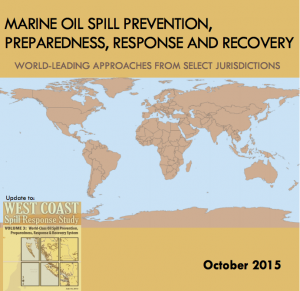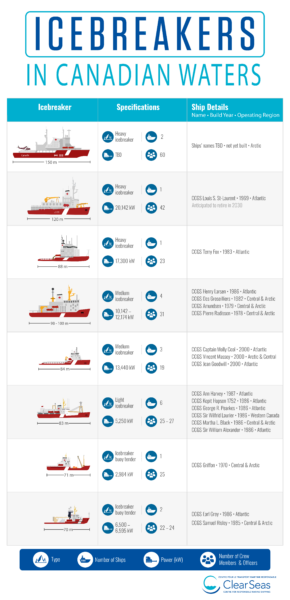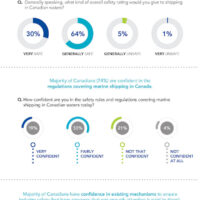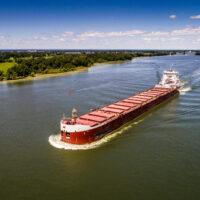This digest covers some of the major observations of the province’s report, specifically those that discuss system element examples from around the world that best describe a world-leading oil spill response system.
Executive Summary
Clear Seas is an independent, not-for-profit organization that provides impartial and evidence-based research to inform the public and policy makers about marine shipping in Canada.
We are providing this digest of the BC Ministry of Environment’s report entitled Marine Oil Spill Prevention, Preparedness, Response and Recovery: World-Leading Approaches From Select Jurisdictions.
This short digest is not meant to be inclusive of all the Review’s commentary and/or recommendations, nor are the items mentioned necessarily in the same order as the original report.
Message from the Executive Director
As shipping volumes increase on Canada’s west coast, and with further major marine transportation projects anticipated for BC ports, the government of British Columbia has a vested interest in better understanding the risks particularly associated with increased ship-based oil movements. To that end the British Columbia Ministry of Environment commissioned Nuka Research to conduct a three-volume study to provide an assessment of the current oil spill prevention and response regime on the west coast. The study was completed in 2013.
For marine oil spill prevention, preparedness, response, and recovery – and the provincial government’s aspiration for a world-leading system – it is important to note that it relies on initiatives that are largely beyond provincial jurisdiction – and on a network of international, federal, provincial, and local regulatory and response authorities. As such the recommendations for BC mentioned in the report must be considered in the context of these other jurisdictional realities.
This Volume (published in October, 2015) entitled Marine Oil Spill Prevention, Preparedness, Response and Recovery: World-Leading Approaches From Select Jurisdictions is an update to the original Volume 3 (published in 2013) West Coast Spill Response Study, Volume 3: World Class Oil Spill Prevention, Preparedness, Response & Recovery System.
This digest covers some of the major observations of this volume, specifically those that discuss system element examples from around the world that best describe a world-leading oil spill response system.
From a Clear Seas perspective, preventing oil spills from happening at all is always the best course of action. However, if they do occur, it is critical that the most efficient mitigation systems are in place. Overlaying all efficient prevention and mitigation systems are the fundamentals of first-rate governance, the pursuit of continuous improvement, and the provision of supplementary funding to cover the cost of spills. From that perspective the examples presented here are worthy of serious consideration by provincial and federal decision makers.

World-Leading Marine Oil Spill Regime System Elements Examples
The 2013 study identified three common system elements of world-class marine oil spill response:
- The government ensures compliance and transparency;
- All parties actively pursue continuous improvement through research and development and the testing of planning assumptions; and
- Comprehensive financial mechanisms and resources.
Speaking to these same elements this update provides the following three examples.
Effective government oversight of industry activities establishes clear expectations that address risks, is transparent to both industry and the public, and provides compelling enforcement mechanisms.
(1) Compliance & Transparency: Norway’s regulation of the offshore oil and gas industry is widely recognized as an effective governance structure and is similar to the UK approach. While Norway’s regime focuses on offshore oil and gas exploration rather than shipping, many of the characteristics of this system could be applied to prevent ship-source oil spills through port and flag state controls.
Norway applies a non-prescriptive approach to self-regulation of the petroleum industry, backed up with a strong enforcement policy. Companies must identify risks and develop plans for the safe operation of their vessels and facilities based on the risks specific to their operations.
Elements of the Norwegian oversight approach encompass: operators having flexibility to meet government safety and prevention standards, but are held strictly accountable to their commitments; focusing on leading indicators and near misses; a governance approach to safety and prevention that favors collaboration and dialogue but allows for punitive measures if needed; a robust civil and criminal penalty structure for pollution; government audits and enforcement actions that are transparent to industry and public; operators may be compelled to make data or studies that relate to safety of petroleum operations publicly available; and with the government actively supporting and participating in research and development and field testing of spill response technologies and capabilities.
When it comes to ensuring compliance and transparency BC and Canada could:
- Consider a performance-based approach that sets measurable standards and allows some flexibility for compliance.
- Track near miss events and other leading indicators and tailor safety and prevention requirements to causality.
- Create a continuum of enforcement mechanisms that includes both civil and criminal penalties for oil spills or safety violations. Engage in cooperative research and development activities with industry.
- Operate transparently and require transparency from industry, including publication of studies, data, and other information of interest to the public and stakeholders.
(2) Continuous Improvement: Citizen engagement and oversight of oil and gas activities has been occurring since at least the 1970s, when the Sullom Voe Oil Spill Advisory Committee was established in the UK to conduct environmental monitoring, provide feedback on oil spill response plans, and participate in drills and exercises.
The One Ocean initiative in Newfoundland and Labrador provides a mechanism for the local fishing industry to collaborate with oil and gas operators on spill preparedness and response.
The US Oil Pollution Act of 1990 established two citizen oversight organizations in Alaska. The stated purpose of the councils was to “involve local citizens in the process of preparing, adopting, and revising oil spill contingency plans,” as one means of avoiding the complacency that many blamed for the Exxon Valdez oil spill of 1989.
The Alaska Regional Citizens Advisory Councils provide an example of citizen oversight systems that operate with sufficient funding and autonomy to maintain clear separation from both industry and regulators. The Councils operate with full transparency to the public they serve and to the industry they oversee. They include representatives of local communities and interest groups, selected by the organizations they represent. The Councils, which are funded by industry, have complete autonomy as long as they operate within their federal mandate.
Considerations for modeling BC and Canada’s approach, based on the Alaska example, include:
- Creating independent, autonomous councils with a defined mission.
- Ensuring broad representation of regional stakeholder interests.
- Allowing participating entities to self-nominate representatives.
- Securing dedicated funding to allow Councils to undertake technical work and participate in planning and preparedness activities.
(3) Comprehensive financial mechanisms & resources: In order for both public and private entities to respond immediately to an oil spill – both to mitigate impacts and to begin the damage assessment process – they must know they can recover any costs expended. Under the polluter pays system, the responsible party is ultimately responsible for these costs. However, having a ready source of existing funding is critical to a prompt response so assets can be mobilized without delays caused by uncertainty about whether the responsible party has been identified or has the ability to pay. Oil spill response funds exist at the international and national levels, with varying caps and constraints on their use.
The US has adopted its own approach to oil spill liability and compensation. It has a broader definition of damages, and applies a more strict form of liability than the international conventions in place. The US Oil Spill Liability Trust Fund (OSLTF) provides an immediate source of funds to facilitate the prompt initiation of response activities and damage assessments. It also provides an additional level of protection to responders and the public above liability limits, or in the event that a responsible party cannot be identified. It applies to spills to navigable waters of the US, or incidents in which no oil is released but there is a substantial threat of a spill. This includes spills from vessels, pipelines and onshore facilities, and offshore facilities. Up to US$1 billion is available per incident.
Considerations for BC and Canada include:
- Evaluating national and international fund reserves and per-incident limits to ensure that adequate funding is available to cover a worst case oil spill, based on a review of recent incident costs worldwide.
- Ensuring that funding can be used for restoration and recovery activities.
- If adequate reserves exist, considering allocating funding to support preparedness and response activities.
Conclusion and Recommendations (covering the entire Volume 3 update)
There is no “one size fits all” blueprint for marine oil spill systems or regimes. Specific regulations, laws, policies, and practices in place in any given jurisdiction are influenced by differences in geography, politics, legal systems, and governance approaches. These differences make it nearly impossible to rank regimes against one another, and the intent of this report is not to issue an international scorecard.
Instead, it presents specific examples of marine oil spill prevention and response practices that are renowned as particularly effective and offers these as established models for British Columbia to consider in building a world-leading regime for the west coast of Canada. Some adaptation may be required to apply these practices and while some could be adopted or adapted at the provincial level, others would require federal or multi-jurisdictional initiatives.
In aggregating this list of world-leading marine oil spill prevention and response system elements, six general themes emerge regarding common characteristics:
- A risk-based approach;
- A multi-layered system;
- A holistic approach;
- Collaboration;
- Accountability; and
- Continuous improvement.
These principles may inform BC and partner jurisdictions as they consider enhancements and improvements to the existing marine oil spill prevention and response system.
In pointing to these themes the report notes that:
- British Columbia can implement a risk-based approach by ensuring that oil spill prevention measures target those locations, activities, or conditions that present a high risk of oil spills and that response planning and preparedness is sufficient to manage the worst possible spill scenario, no matter how unlikely.
- A world-leading marine oil spill prevention system for BC should have multiple layers of prevention and response in place. Prevention measures should target different components of risk, and should consider how each measure might interrupt the chain of events that could lead to an oil spill.
- There should be a holistic approach to balancing prevention and response. Such an approach requires that the entire system be considered in preventing and responding to oil spills. Initiatives that are tied to a single energy project or a single risk-causing activity must be integrated into a system-wide approach. In order for a prevention or response measure to reduce risks and consequences, it must be available across the entire system and not tied to a specific facility or operational sector.
- A world-leading regime in BC must be collaborative and transparent. Marine oil spills bring together federal, provincial, local and First Nation governments, along with the private sector and the public. Efforts to work collaboratively on oil spill prevention and response initiatives will build relationships and trust. Transparency to the public and the regulated industry will also contribute to building trust and creating predictability.
- As the BC and Canadian governments move forward with new initiatives, it is critical to incorporate an accountability structure within both government and industry. Government authorities should also be accountable to stakeholders and the public at large. Auditing and oversight is a key component to many of the examples included here, and this is a critical distinction of world-leading regimes.
- Finally, a world-leading regime does not rest on its laurels but rather incorporates mechanisms for frequent self-evaluation to drive continuous improvement. Marine oil spill prevention and response initiatives should be designed with a clear purpose and measurable objectives that can be used to evaluate program effectiveness and spur further refinement and improvement.
Next Steps
As suggested earlier, the province does not have direct jurisdiction over many of the issues involved in marine oil spill prevention and response; therefore, implementation of a world-leading regime will require a broad effort that includes federal and international partners. There are a number of parallel efforts ongoing in Canada and there may be opportunities to synergize efforts with some of these other initiatives that are looking at similar issues.
The report stops short of assessing the present system in BC, but this may be a logical next step. The elements identified in this report and the list of considerations for the province could be used to analyze gaps in the current system and frame the discussion of ongoing and potential new initiatives.
In addition, the province may benefit from direct knowledge sharing with some of the entities and governments profiled in this report. Existing forums for sharing best practices regarding oil spill prevention and response, such as international agreements like the Paris and Tokyo MOUs, professional conferences such as Environment Canada’s annual Arctic Marine Oil Pollution seminar, or standing organizations like the Pacific States/BC Oil Spill Task Force, provide an opportunity to discuss outstanding issues.
British Columbia may also consider convening a workshop similar to the 2013 Land-based Oil Spill Preparedness symposium to focus discussion specifically on BC’s marine oil spill prevention and response system and to develop consensus about priorities for achieving a world-leading regime.



